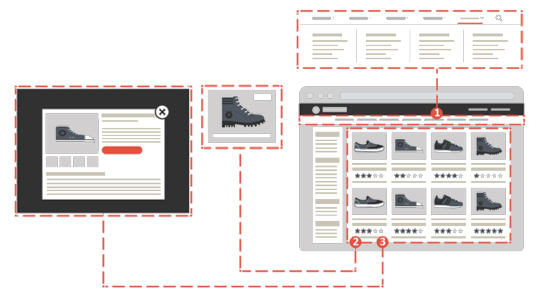You’ve decided to test the effectiveness of your website, but you’re not sure where to start. Perhaps you’ve heard about A/B and multivariate testing, but you’re not clear on the differences between the two, or which is the best approach for your brand.
When it comes to website optimization, A/B testing and multivariate testing each have distinct advantages and drawbacks. Let’s compare the two and determine which is the best option for your website.
A/B Testing
A/B testing is the simpler of the two testing methods. It involves creating two versions of a single element of the page or campaign, while keeping everything else the same. Then you see which version—variant A or variant B— performs better. And since you’ve changed nothing else, you know the performance difference is due to the change in the one element.
For instance, to optimize your website, you could A/B test the placement of a product side rail (see diagram below).
After setting up the two variants, you would typically split the traffic 50/50 between them. In our example, you’d send 50% of the traffic to variant A, which has the product side rail on the right, which is where you currently have it on your website. Variant A is the control.
Then you’d send the remaining 50% of your traffic to variant B, which has the product side rail on the left. This is our test experience that we think will outperform the control.
The test would then remain live until the data has reached statistical significance—a determination that the difference in result between the control and test variant is due to something other than sheer chance. From there, you measure which version of the test drives improvements in your desired key performance indicator (KPI). This is where some marketers go wrong. They choose the wrong KPI, which leads them to optimize for behaviors that don’t necessarily drive their desired outcome.
Which metric is the right one to use as your KPI? Typically, you want a conversion-focused KPI, since you’re generally trying to get visitors to complete a desired action. For example, with our product side rail test, you could measure how many clicks or product page views each variant generated, but you’d be better off measuring the purchases generated by each, since that’s your ultimate goal. While the variant that wins on conversions will probably also win on clicks, that won’t always be the case. So, you’re almost always better off using metrics farther down the funnel as the victory metric for your tests.
If you were testing an element that doesn’t lead to a sales conversion, you’ll still want to optimize for deeper behaviors. For example, if you were A/B testing the appeal language on an email signup popup form, then you’d look at new signup completions. And, if you wanted to go a step farther, you could look at signups that confirm their subscriptions (if you’re using double opt-in) and even the number of subscribers who engage during their first month.
To avoid costly mistakes, steer clear of these A/B testing pitfalls.
Multivariate Testing
Multivariate testing (MVT) is the more complicated of the two testing methods. Unlike A/B testing, multivariate testing involves changing multiple elements of a page or campaign at once.
For instance, continuing with our product side rail example, you could use MVT to experiment with a variety of elements simultaneously, including the:
- Product text
- Product imagery
- Call-to-action button color and styling
- Call-to-action wording
- Placement of product listing elements in relation to each other
- Inclusion or exclusion of various product list elements
MVT’s greatest strength is it allows you to much more quickly and easily see how changes in various elements enhance or detract from one another. If A/B testing was used to discover these cross-element interactions, it would take much longer and involve many more tests.
The downside of MVT is much more traffic has to be split among all the versions. So, instead of splitting traffic randomly between the two versions of an A/B test, you have to split traffic among all of the potential combinations of every element variation. To find the total number of variants in a multivariate test, apply the following formula:
(# of variations of 1st element) x (# of variations of 2nd element) x … = Total # of variants
For instance, let’s return to our example of an email signup popup. Let’s say you wanted to test three elements:
- The signup appeal language
- The image accompanying the appeal
- The timing of the popup modal
If you have an existing version (A) and a single test version (B) for each of the three elements, then you’d have a total of 8 variants (2 x 2 x 2), with one control and 7 test versions.
| Element |
Control |
Variant 1 |
Variant 2 |
Variant 3 |
Variant 4 |
Variant 5 |
Variant 6 |
Variant 7 |
| Appeal |
A |
A |
A |
A |
B |
B |
B |
B |
| Image |
A |
A |
B |
B |
A |
A |
B |
B |
| Timing |
A |
B |
A |
B |
A |
B |
A |
B |
If you added a second test version (C) of each of the three elements, then you’d have a total of 27 variants (3 x 3 x 3). And if you added a fourth element and tested two test versions of that as well, then you’d have 81 variants (3 x 3 x 3 x 3). So, the total number of variants can grow quickly as you add test versions or additional elements.
Learn how Brazilian retailer Armazém Paraíba uses testing and website optimization to better manage their sales channels and understand consumer behavior.
Which Is Right for You?
When determining which method is best for your website, you should consider many factors, such as your goals, web traffic, time frame, and expertise.
When A/B Testing Is Best
When first beginning website optimization, it’s probably best to start with A/B testing, as it is a less complex testing method with a simpler test structure.
A/B testing is also a better option if the amount of traffic you receive on your web page is low. By having fewer variants, tests can reach statistical significance and conclude quicker than with multivariate testing, which requires greater web traffic to provide reliable data.
Should you want to test a single page element but have more than two versions of that element, an extension of A/B testing known as A/B/n testing is the answer. A/B/n testing allows an extended number of variants to exist—from the third to the nth version—to determine which performs the best.
When Multivariate Testing Is Best
On the other hand, multivariate testing is much better suited to large-scale tests, such as homepage redesigns where you want to simultaneously test many elements of the page, such as images, copy, and specific audience segments.
Also, if your website attracts a high level of traffic and you have the luxury of a longer time frame, then running an MVT is a very powerful way to test the effectiveness and will save you the hassle of creating numerous A/B tests.
While MVTs may sound intimidating, they can be an invaluable source of information for uncovering the best combinations of elements. However, when testing on rapidly changing sites, it’s generally best to avoid MVT testing. That’s because winning experiences derived from MVT testing rely on the interplay between the different elements of that experience, and that interplay is disrupted if content is routinely changing. In these cases, A/B/n testing allows for faster and more reliable iteration of new test ideas.
You Should Use Both
A/B testing and multivariate testing are two different paths to the same goal: providing consistently optimized experiences for your consumers. So, many brands will find that they use both methods in different circumstances.
Regardless of which method you use, it’s important to view website optimization as an ongoing process. As consumers, markets, and commercial climates change, so should your testing strategy. Doing so ensures your website is consistently optimized to drive the highest conversion rates and the optimal customer experiences.
—————
Need help planning, executing, or analyzing testing? Oracle Digital Experience Agency has hundreds of marketing and communication experts ready to help Oracle customers create stronger connections with their customers, partners, and employees, even if they’re not using an Oracle platform as the foundation of that experience. Handling everything from creative and strategy to content planning and project management, we consistently exceed our clients’ expectations, earning a customer satisfaction rate of 96%.
For help overcoming your challenges or seizing your opportunities, talk to your Oracle account manager, visit us online, or email us at OracleAgency_US@Oracle.com.
Now updated, this blog post was originally published on May 18, 2022 by Christopher Santini.


